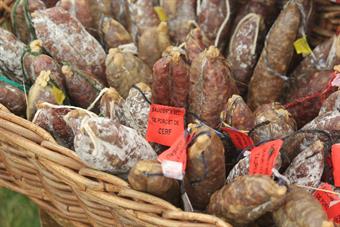Drying Meat
 Indigenous people have air dried meats for hundreds of years. They have often used lean meat cut thinly into strips. This product is ready to consume when the texture becomes hard after hanging in the sun.
Indigenous people have air dried meats for hundreds of years. They have often used lean meat cut thinly into strips. This product is ready to consume when the texture becomes hard after hanging in the sun.
The drying method of curing meat was sometimes used on its own - but also in conjunction with other methods of preserving, such as curing.
Traditionally, indigenous people made dried strips of meat (e.g. beef sticks) or fillets of fish, by firstly salting, then drying either in the sun, or in ovens at 70-80oC. Drying using natural conditions is less common today than it was once.
WHAT DRYING DOES
Drying decreases the water content in the food, and as such, decreases the microbial activity, and increase the shelf life of the food. Different types of microorganisms will require different levels of moisture in which to survive and be active. If the moisture levels in meat can be decreased below those levels, the deterioration of the meat caused by microbes will slow or stop completely.
This is not an exact science though; because factors other than just water content can also affect microbial activity. Temperature is an obvious factor. Composition of the meat is also important (particularly fat content).
What Meats to Use
Dried meat will keep for months at room temperatures provided fatty tissue has been removed; fats will become rancid much faster than animal muscle tissue.
The most suitable meats for drying are lean meats. Particularly useful meats used for drying are beef, goat, venison and wild game animals. Mutton is less suitable, and pork even less so. Cattle breeds developed to produce marbled meat (e.g. Wagyu) may be more problematic (for drying) than lean meat breeds.
Sun Drying
Meat was traditionally dried using the energy of the sun plus air circulation. The meat was cut into flat strips (approximately 1cm thick and wide), dipped into a salt solution (using about 15% common table salt) and then suspended from rafters or similar and ‘hung out to dry’. Alternatively the strips can be placed on open racks made of wire mesh or even fibre set within a timber or metal frame. The salt solution helps to prevent microbial growth on the surface of the meat. Both these methods create problems – it is difficult to prevent exposure to contamination through insect infestation, rodents and other animals and exposure to the elements. It is also encourages dirt and possible microbial growth on the meat’s surface which can lead to contamination and subsequent food poisoning when consumed.
To over-come and limit such contamination the meat must be dried quickly – within 8 or 10 hours but may take up to 2 days. This can be achieved if the meat is sliced thinly (approximately 1cm thick is ideal) and only placed in the open air during daylight hours where the meat can be observed regularly. If the meat is not dry within the given period, it is best to bring it indoors and stored in a dry, secure place (free from insects and rodents) and to hang it out again the following day.
Note: the meat strips must be cut thin because thicker meat tends to air-dry on the outside, but not on the inside which remains moist.
This is an extract from our ebook on Preserving Meat and Fish
or check out what's in the book and buy a copy at http://www.acsebooks.com/product-preserving-meat-and-fish-pdf-ebook-6111.aspx